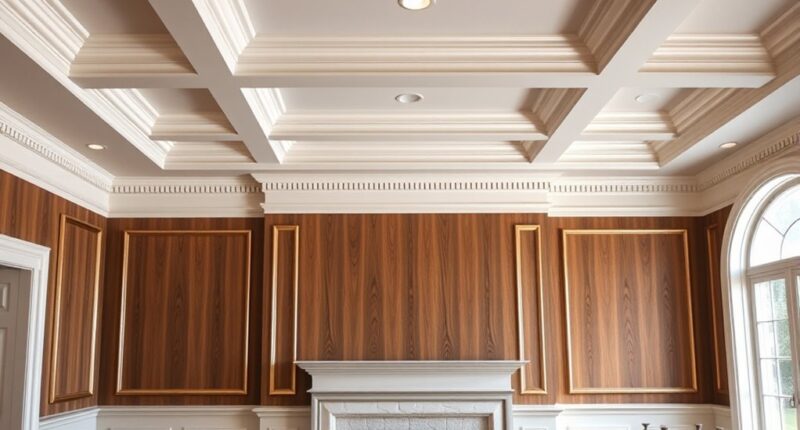To elevate your rooms with elegant millwork, focus on selecting the right molding and paneling styles that match your design vision. Incorporate crown molding, chair rails, or ornate profiles for a traditional look, or choose sleek, simple profiles for modern spaces. Use paneling to define areas, add texture, or create visual interest. Proper installation, finishing, and maintenance help enhance the beauty and longevity of your details. Keep going to discover how to perfect your approach for stunning results.
Key Takeaways
- Incorporate crown molding and chair rails to create sophisticated transitions and add visual interest to rooms.
- Choose paneling styles and materials that complement your interior design for texture and depth.
- Use proportion, scale, and color coordination to establish a balanced visual hierarchy and focal points.
- Select appropriate materials like wood or MDF to match your style, durability needs, and budget.
- Pay attention to precise installation, finishing, and maintenance to ensure a polished, elegant appearance.
Exploring Different Types of Molding and Their Uses

Have you ever wondered how different types of molding can enhance the look of a room? Ornamental profiles come in various styles, each adding a unique character to your space. Crown molding, for example, creates an elegant connection between walls and ceilings, while chair rails protect walls and add visual interest. When choosing molding, material options matter. Wood offers warmth and authenticity, but you can also consider MDF for affordability or polyurethane for intricate, detailed profiles. Your selection depends on the room’s style and your maintenance preferences. By understanding these ornamental profiles and material choices, you can craft a refined, cohesive look that elevates your space effortlessly. The right molding transforms ordinary rooms into extraordinary ones. Additionally, incorporating rustic elements like reclaimed wood moldings can further enhance a farmhouse aesthetic.
Selecting the Perfect Paneling Styles for Your Space

Choosing the right paneling style can transform your space by adding depth, texture, and personality. To do this effectively, consider these key factors:
- Material textures — choose between smooth, rough, or distressed finishes to match your desired feel.
- Historical influences — incorporate details inspired by classic or period styles for timeless elegance.
- Room function — select paneling that complements whether it’s a cozy nook or a formal dining area.
- Visual impact — opt for wide or narrow panels, depending on whether you want to create a sense of spaciousness or intimacy.
Incorporating Molding in Traditional and Contemporary Designs

You can enhance your space by carefully choosing moldings that match your design style. Whether you’re going for a classic or modern look, selecting the right molding helps create a cohesive feel. Consider how different moldings complement your overall decor to achieve the desired aesthetic. Additionally, understanding cybersecurity vulnerabilities can help ensure that your home automation and smart devices remain protected as you upgrade your interior spaces.
Complementing Design Styles
Incorporating molding into your interior design can seamlessly enhance both traditional and contemporary styles, creating a cohesive and polished look. To achieve this, consider how historical influences and cultural aesthetics shape your choices. Here are four ways to complement your design:
- Use ornate moldings to evoke historical grandeur in traditional spaces.
- Opt for sleek, minimal profiles that reflect contemporary simplicity.
- Incorporate cultural motifs to add personalized depth and storytelling.
- Balance scale and detail to harmonize the aesthetic, ensuring each element supports your overall vision.
- Understanding precious metals assets helps in choosing materials that add value and sophistication to your space.
Understanding these principles helps you select moldings that respect your space’s roots while maintaining modern appeal. The right moldings serve as a bridge between eras, enriching your interior with meaning and visual harmony.
Selecting Appropriate Moldings
How can you select moldings that perfectly suit both traditional and contemporary interiors? Start by considering material durability, ensuring the molding withstands daily wear while matching your style. For traditional spaces, opt for ornate, richly detailed moldings made from high-quality wood or plaster, which add elegance and timeless appeal. In contemporary designs, choose sleek, simple profiles with clean lines, often crafted from durable materials like MDF or PVC that mimic wood but are more budget-friendly. Your budget considerations influence your choice: investing in real wood enhances authenticity but costs more, while composite materials offer durability and affordability. Additionally, understanding self watering plant pots can inspire creative approaches to integrating natural elements into your interior decor. Ultimately, selecting moldings that balance material durability, style, and budget will seamlessly elevate your room’s aesthetic, whether traditional or modern.
Creative Ways to Use Paneling to Define Spaces

Paneling offers a versatile way to define and differentiate spaces within your home, transforming open areas into cozy, distinct zones. You can use it creatively with:
Paneling transforms open spaces into cozy, stylish zones with versatile options like dividers, accent walls, and textured details.
- Room dividers to create private nooks without sacrificing style.
- Accent walls that set a specific mood or highlight architectural details.
- Acoustic paneling to improve sound quality and define spaces through texture.
- Wainscoting or half-wall paneling to add elegance while separating areas seamlessly.
Combining Molding and Paneling for a Cohesive Look

To create a seamless look, you need to guarantee your molding and paneling share a consistent design flow. Using color coordination techniques helps tie the elements together, making the space feel unified. Achieving proportional balance between molding and paneling completes the look, giving your room a polished, cohesive appearance.
Consistent Design Flow
Achieving a seamless design flow involves carefully coordinating molding and paneling so they complement each other throughout a space. To do this effectively, consider these principles:
- Match architectural detailing styles to maintain consistency with historical influences.
- Use similar profiles and proportions to create visual harmony.
- Align panel heights with molding lines to guide the eye smoothly across walls.
- Balance bold and subtle elements to avoid visual overload.
Color Coordination Techniques
When combining molding and paneling, thoughtful color coordination is essential to create a unified and harmonious look. You should focus on effective color pairing, choosing shades that complement each other and enhance the room’s style. Consider using neutral tones for the molding and paneling as a base, then introduce accent colors to add visual interest. You can also opt for contrasting hues for a bold statement or monochromatic schemes for subtle elegance. Here’s a guide to help:
| Base Color | Accent Color | Finish Type |
|---|---|---|
| White | Navy Blue | Matte or Gloss |
| Gray | Soft Yellow | Satin |
| Beige | Deep Green | Semi-Gloss |
This approach guarantees your molding and paneling work cohesively, elevating your room’s aesthetic. Incorporating color coordination techniques can also help in achieving a balanced and polished look.
Proportional Balance Achieved
Harmonizing the proportions of molding and paneling guarantees a balanced and visually appealing space. Achieving proportional balance is about understanding how symmetry and asymmetry influence visual weight. To create harmony:
- Use symmetrical molding and paneling in formal areas for a sense of stability.
- Introduce asymmetry intentionally to add interest without disrupting balance.
- Match the scale of moldings to the size of the panels for cohesive proportions.
- Adjust the height and width to distribute visual weight evenly throughout the room.
- Considering visual hierarchy helps in planning the overall proportion and emphasis within your design.
DIY Tips for Installing Molding and Paneling

Installing molding and paneling can transform a room, but proper technique makes all the difference. To honor historical craftsmanship, take your time measuring and marking each piece accurately. Use a level frequently to ensure your moldings stay straight and aligned. When selecting materials, prioritize durability—solid wood or high-quality MDF will last longer and maintain their appearance. Always cut with precision, making sure joints fit tightly for a seamless look. Nail or glue pieces securely, but avoid overdriving nails, which can cause splitting. Fill gaps and nail holes with wood filler, then sand smoothly. Double-check your work at each step, and don’t rush the process. With patience and attention to detail, you’ll create a polished, professional finish that elevates your space.
Color and Finish Options to Enhance Your Millwork

Choosing the right color and finish can dramatically enhance the look of your millwork, highlighting its craftsmanship and complementing your room’s decor. Your color palette sets the tone, while finish options add depth and texture. Consider these key choices:
- Neutral tones like whites and grays create a timeless, versatile backdrop.
- Bold colors such as navy or emerald make your millwork stand out as focal points.
- Matte finishes offer a modern, understated elegance that minimizes glare.
- Glossy finishes provide a luxurious shine, emphasizing details and craftsmanship.
- Exploring the history and evolution of artistic movements such as Cubism and abstract art can inspire unique design choices in your millwork.
Maintenance and Care for Your Elegant Millwork

To keep your elegant millwork looking its best, regular maintenance is essential. Establish simple cleaning routines using a soft cloth and gentle cleaner to remove dust and dirt. Avoid harsh chemicals that may damage the finish. For repairs, knowing basic repair techniques can restore your millwork’s appearance quickly. Use wood filler for minor scratches or dents, and sand smoothly before reapplying finish. Keep a small kit handy for touch-ups to prevent further damage. Additionally, understanding home maintenance can help extend the life of your millwork and maintain its aesthetic appeal.
Frequently Asked Questions
How Can I Choose Molding and Paneling to Match My Existing Decor?
When choosing molding and paneling, focus on decor coordination and style compatibility. You should pick designs that complement your existing furniture, color scheme, and architectural details. For a cohesive look, match the molding’s finish and profile with your decor’s style—whether modern, classic, or rustic. Consider the room’s overall vibe and select pieces that enhance, rather than clash with, your current decor to create a polished, unified space.
What Are the Latest Trends in Millwork Design?
You’re curious about the latest trends in millwork design. Today, you’ll notice innovative finishes that add texture and depth, making your spaces stand out. Custom profiles are also gaining popularity, allowing you to personalize moldings to match your style perfectly. These trends help you create a unique, sophisticated look, blending traditional craftsmanship with modern aesthetics. Embrace these updates to elevate your rooms with stylish, one-of-a-kind millwork.
How Do I Budget Effectively for Molding and Paneling Projects?
Think of your project as a garden—you need a solid plan to avoid weeds. Start with a cost comparison of materials and textures to find what fits your budget. Consider DIY installation to save on labor costs, but weigh it against your skill level. Set a clear budget, include extra for unexpected expenses, and prioritize key areas. With careful planning, you’ll turn your space into a masterpiece without breaking the bank.
Can I Incorporate Lighting Into My Molding and Paneling Designs?
Yes, you can incorporate lighting into your molding and paneling designs. Consider using integrated lighting options like LED strips or puck lights for indirect illumination, which adds warmth and ambiance to your space. Plan your design to hide the lighting elements within the molding or paneling, ensuring a seamless look. This approach enhances the room’s elegance while providing functional illumination that highlights your millwork features beautifully.
What Are Eco-Friendly Options for Sustainable Millwork Materials?
You can choose eco-friendly millwork materials by opting for recycled materials like reclaimed wood or bamboo, which are sustainable and add character. Additionally, look for low VOC finishes that reduce indoor air pollution and are better for the environment. These choices help you create beautiful, sustainable molding and paneling that support eco-conscious living without compromising style or quality.
Conclusion
With the right molding and paneling, you turn your space into a symphony of style, where every detail whispers elegance. Think of your room as a canvas, and your millwork as the brushstrokes that bring it to life. When you choose, install, and care for these elements thoughtfully, you craft a timeless masterpiece that reflects your vision. Let your rooms tell a story of sophistication, layered with texture and personality.









